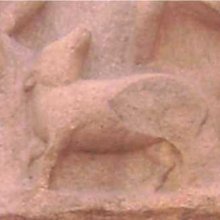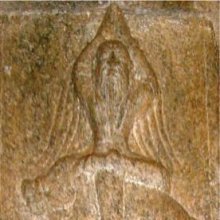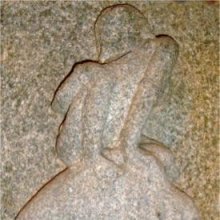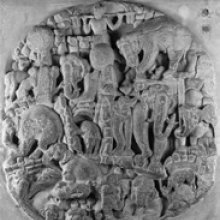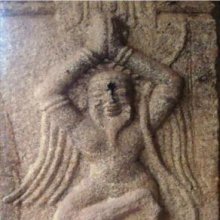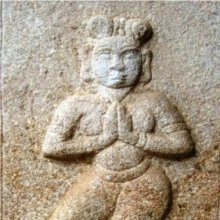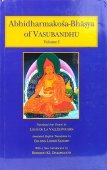Boar: 4 definitions
Introduction:
Boar means something in Buddhism, Pali, Hinduism, Sanskrit, the history of ancient India. If you want to know the exact meaning, history, etymology or English translation of this term then check out the descriptions on this page. Add your comment or reference to a book if you want to contribute to this summary article.
Images (photo gallery)
(+20 more images available)
In Hinduism
Natyashastra (theatrics and dramaturgy)
Source: Shodhganga: Elements of Art and Architecture in the Trtiyakhanda of the Visnudharmottarapurana (natya)The Boar is denoted by the Sanskrit term Varāha, whereas Varāhāvatāra refers to one the Daśāvatāra (“ten incarnations”) (of Lord Viṣṇu) to which are assign various hand gestures (in Indian Dramas), according to the Viṣṇudharmottarapurāṇa, an ancient Sanskrit text which (being encyclopedic in nature) deals with a variety of cultural topics such as arts, architecture, music, grammar and astronomy.—The varāha kind of incarnation of lord Viṣṇu denotes that avatāra, when lord Viṣṇu transforms to the shape of a varāha i.e., a boar. In the Viṣṇudharmottarapurāṇa varāhāvatāra is suggested to show with the śikharahasta where the little finger is extended.

Natyashastra (नाट्यशास्त्र, nāṭyaśāstra) refers to both the ancient Indian tradition (shastra) of performing arts, (natya—theatrics, drama, dance, music), as well as the name of a Sanskrit work dealing with these subjects. It also teaches the rules for composing Dramatic plays (nataka), construction and performance of Theater, and Poetic works (kavya).
Ayurveda (science of life)
Toxicology (Study and Treatment of poison)
Source: Shodhganga: Kasyapa Samhita—Text on Visha ChikitsaThe Boar is denoted by the Sanskrit term Kroḍa and is mentioned as one of the sworn enemies of Snakes (Sarpas), as taught in the Kāśyapa Saṃhitā: an ancient Sanskrit text from the Pāñcarātra tradition dealing with both Tantra and Viṣacikitsā (Toxicology).—The Kāśyapasaṃhitā (verse IV.33) talks about the sworn enemies of Sarpas (snakes): Kroḍa (boar), lightning, peacock, eagle, cat, mongoose and wolf are its sworn enemies.

Āyurveda (आयुर्वेद, ayurveda) is a branch of Indian science dealing with medicine, herbalism, taxology, anatomy, surgery, alchemy and related topics. Traditional practice of Āyurveda in ancient India dates back to at least the first millenium BC. Literature is commonly written in Sanskrit using various poetic metres.
In Buddhism
Tibetan Buddhism (Vajrayana or tantric Buddhism)
Source: academia.edu: The Structure and Meanings of the Heruka MaṇḍalaThe Boar (animal) is associated with the Yoginī (female deity) named Sūkarī, being situated in the Medinīcakra, according to the 10th century Ḍākārṇava-tantra: one of the last Tibetan Tantric scriptures belonging to the Buddhist Saṃvara tradition consisting of 51 chapters.—Accordingly, the medinīcakra refers to one of the three divisions of the dharma-puṭa (‘dharma layer’), situated in the Herukamaṇḍala. The 36 pairs of Ḍākinīs [viz., Sūkarī] and Vīras are yellow in color; the shapes of their faces are in accordance with their names [e.g., Boar]; they have four arms; they hold a skull bowl, a skull staff, a small drum, and a knife.

Tibetan Buddhism includes schools such as Nyingma, Kadampa, Kagyu and Gelug. Their primary canon of literature is divided in two broad categories: The Kangyur, which consists of Buddha’s words, and the Tengyur, which includes commentaries from various sources. Esotericism and tantra techniques (vajrayāna) are collected indepently.
India history and geography
Source: Singhi Jain Series: Ratnaprabha-suri’s Kuvalayamala-katha (history)Boars were commonly depicted on the Saṃsāracakra paintings (representing scenes of animal life), in ancient India, as mentioned in the Kathās (narrative poems) such as Uddyotanasūri in his 8th-century Kuvalayamālā (a Prakrit Campū, similar to Kāvya poetry).—Page 185.21 f.: Here follows a description of a printed scroll illustrating the Jaina conception of saṃsāracakra. [...] The saṃsāra-cakra illustrated the three worlds of hell, human world and the world of gods. [For example:] A number of animals making a composite form, one upon another: spider caught in the web of another spider, the latter catching an insect pursued by a lizard and the latter caught by a black bird which flying in the sky with its feed was caught by a bird of prey, and the latter falling to the ground was caught by a wild cat which in turn was attacked by a wild boar, the latter was being attacked by leopard, and the leopard was attacked by a tiger, the latter instantaneously by a lion and the lion by a wild Śarabha (stronger than a lion and said to have eight feet).

The history of India traces the identification of countries, villages, towns and other regions of India, as well as mythology, zoology, royal dynasties, rulers, tribes, local festivities and traditions and regional languages. Ancient India enjoyed religious freedom and encourages the path of Dharma, a concept common to Buddhism, Hinduism, and Jainism.
See also (Relevant definitions)
Starts with: Boar blood, Boar flesh, Boar marrow, Boar thistle, Boar tooth, Board, Boarda goomoodoo.
Ends with: Boar blood, Boar flesh, Boar marrow, Boar tooth, Wild boar.
Full-text (+462): Varaha, Nrivaraha, Yajnavaraha, Sthiradamshtra, Mahavaraha, Potrin, Sukara, Saukarika, Asyalangala, Vakradamshtra, Varahavatara, Nighrishva, Varahayu, Vriddhakola, Prithuskandha, Shrivaraha, Adivaraha, Udghona, Vishana, Varahakalpa.
Relevant text
Search found 155 books and stories containing Boar; (plurals include: Boars). You can also click to the full overview containing English textual excerpts. Below are direct links for the most relevant articles:
Village Folk-tales of Ceylon (Sri Lanka), vol. 1-3 (by Henry Parker)
Story 71 - How The Boars Killed The Rakshasa < [Part II (d) - Stories of the Rodiyas]
Story 68 - The Lion And The Jackal < [Part II (c) - Stories of the Durayas]
Story 50 - The Nikini Story < [Part II (b) - Stories of the Tom-tom Beaters]
The Jataka tales [English], Volume 1-6 (by Robert Chalmers)
Jataka 283: Vaḍḍhaki-Sūkara-jātaka < [Book III - Tika-Nipāta]
Jataka 492: Taccha-Sūkara-jātaka < [Volume 4]
Jataka 153: Sūkara-Jātaka < [Book II - Dukanipāta]
The Padma Purana (by N.A. Deshpande)
Chapter 43 - The Boar Gives a Tough Fight to Ikṣvāku < [Section 2 - Bhūmi-khaṇḍa (section on the earth)]
Chapter 42 - Ikṣvāku Goes Ahunting < [Section 2 - Bhūmi-khaṇḍa (section on the earth)]
Chapter 44 - The Boar Dies Fighting < [Section 2 - Bhūmi-khaṇḍa (section on the earth)]
Manusmriti with the Commentary of Medhatithi (by Ganganatha Jha)
Verse 3.270 < [Section XXI - Relative Merits of the Offering-Materials]
Verse 8.239 < [Section XXXIX - Disputes between Owner and Keeper]
Verse 11.134 < [Section XV - Expiation for the killing of Cats and other Animals]
Diaspora of Bhuta (Daiva) worshipping cult—India and Indonesia (by Shilpa V. Sonawane)
Part 3 - Deva Daiva Bhuta < [Chapter 1 - Introduction]
Part 10 - Dewi Sri: Indonesia < [Chapter 1 - Introduction]
Varahi Tantra (English Study) (by Roberta Pamio)
The Goddess Vārāhī (Introduction)
Chapter 1 - The origin of the Vārāhī Tantra < [Summary of the Vārāhī Tantra]
Chapter 36 - The Pūjā (worship) of the Goddess Vārāhī < [Summary of the Vārāhī Tantra]
Related products
